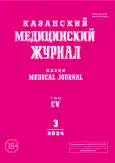Кластерный подход к идентификации 5-летнего прогноза пациентов с хронической сердечной недостаточностью ишемической этиологии
- Авторы: Хазова Е.В.1,2
-
Учреждения:
- Казанский государственный медицинский университет
- Казанский (Приволжский) федеральный университет
- Выпуск: Том 105, № 3 (2024)
- Страницы: 396-406
- Тип: Теоретическая и клиническая медицина
- URL: https://bakhtiniada.ru/kazanmedj/article/view/257024
- DOI: https://doi.org/10.17816/KMJ624249
- ID: 257024
Цитировать
Аннотация
Актуальность. Фенотипическая и патофизиологическая гетерогенность пациентов с хронической сердечной недостаточностью повышает интерес исследователей к группированию по схожим клиническим, генетическим характеристикам на основе кластерного анализа.
Цель. Выделить фенотипические подгруппы в многомерной когорте пациентов с хронической сердечной недостаточностью на фоне ишемической болезни сердца с использованием неконтролируемого кластерного анализа клинических, инструментальных и генетических компонентов.
Материал и методы. Обследованы 470 пациентов с хронической сердечной недостаточностью I–IV функционального класса, стабильного течения, ишемической этиологии обоего пола в возрасте 66,4±10,4 года. Проводили клиническое исследование, генотипирование однонуклеотидных полиморфизмов rs10927875 гена ZBTB17, rs247616 гена CETP, rs1143634 гена IL-1β, rs1800629 гена TNF, rs1800795 гена IL-6, оценивали исходы пациентов в течение 5 лет. Количественные данные представлены как среднее значение и стандартное отклонение либо медиана и межквартильный диапазон; категориальные — как частоты и проценты. Категориальные межгрупповые различия проверяли критерием χ2, количественные — тестом Стьюдента/Манна–Уитни. Проводили иерархическую кластеризацию по 44 демографическим, клиническим, генетическим переменным, время до наступления события анализировали методом Каплана–Мейера, отношение рисков — регрессией Кокса. Статистическая обработка проведена в программе R4.3.1.
Результаты. Идентифицировано 2 кластера пациентов с сердечной недостаточностью. В кластере 1 (66%) были пациенты старшего возраста обоего пола, преимущественно III–IV функционального класса хронической сердечной недостаточности, с увеличенными камерами сердца, сниженной фракцией выброса левого желудочка, большей частотой сердечных сокращений, фибрилляции предсердий и гипертрофии левого желудочка. В данном кластере выявлено больше носителей GG-генотипа полиморфизма rs1800795 гена IL-6 (р <0,001) и СТ-генотипа полиморфизма rs247616 гена CETP (р=0,014). Кластер 2 (34%) представлен преимущественно женщинами более молодого возраста, с бóльшим метаболическим индексом, перенесённым в прошлом инфарктом миокарда и коронарным вмешательством, курящих, большей долей ТТ-генотипа полиморфизма rs247616 гена CETP (р=0,029).
Вывод. Выделено 2 кластера пациентов с хронической сердечной недостаточностью, характеризующихся разным набором 44 переменных, определяющих риск смерти от всех причин.
Полный текст
Открыть статью на сайте журналаОб авторах
Елена Владимировна Хазова
Казанский государственный медицинский университет; Казанский (Приволжский) федеральный университет
Автор, ответственный за переписку.
Email: hazova_elena@mail.ru
ORCID iD: 0000-0001-8050-2892
SPIN-код: 7013-4320
Scopus Author ID: 57205153574
ResearcherId: O-2336-2016
канд. мед. наук, доц., каф. пропедевтики внутренних болезней им. проф. С.С. Зимницкого, ФГБОУ ВО Казанский ГМУ Минздрава России; науч. сотр., УНИЛ «Новые профессиональные компетенции по здоровьесбережению», Институт фундаментальной медицины и биологии
Россия, г. Казань; г. КазаньСписок литературы
- Heinzel F.R., Shah S.J. The future of heart failure with preserved ejection fraction: Deep phenotyping for targeted therapeutics // Herz. 2022. Vol. 47, N. 4. P. 308–323. doi: 10.1007/s00059-022-05124-8
- Cleland J.G, Pellicori P., Dierckx R. Clinical trials in patients with heart failure and preserved left ventricular ejection fraction // Heart Fail Clin. 2014. Vol. 10, N. 3. P. 511–523. doi: 10.1016/j.hfc.2014.04.011
- Potabashniy V.A. The phenotypes of chronic heart failure in patients with ischemic heart disease combined with chronic obstructive pulmonary disease // Medicni perspektivi. 2018. Vol. 23, N. 3. P. 161–171. doi: 10.26641/2307-0404.2018.3(part1).142364
- Полунина Е.А., Воронина Л.П., Попов Е.А., и др. Прогностические алгоритмы прогрессирования хронической сердечной недостаточности в зависимости от клинического фенотипа // Кардиоваскулярная терапия и профилактика. 2019. Vol. 18, N. 3. P. 41–47. doi: 10.15829/1728-8800-2019-3-41-47
- Shah S.J., Katz D.H., Selvaraj S., et al. Phenomapping for novel classification of heart failure with preserved ejection fraction // Circulation. 2015. Vol. 131, N. 3. P. 269–279. doi: 10.1161/CIRCULATIONAHA.114.010637
- Sun J., Guo H., Wang W., et al. Identifying novel subgroups in heart failure patients with unsupervised machine learning: A scoping review // Front Cardiovasc Med. 2022. Vol. 9. P. 895836. doi: 10.3389/fcvm.2022.895836
- Cohen J.B., Schrauben S.J., Zhao L., et al. Clinical phenogroups in heart failure with preserved ejection fraction: Detailed phenotypes. Prognosis, and response to Spironolactone // JACC Hear Fail. 2020. Vol. 8. P. 172–184. doi: 10.1016/j.jchf.2019.09.009
- Woolley R.J., Ceelen D., Ouwerkerk W., et al. Machine learning based on biomarker profiles identifies distinct subgroups of heart failure with preserved ejection fraction // Eur J Heart Fail. 2021. Vol. 23. P. 983–991 doi: 10.1002/ejhf.2144
- Цыганкова О.В., Веретюк В.В. Фенотипические кластеры пациентов с хронической сердечной недостаточностью с сохранённой и промежуточной фракцией выброса: новые данные и перспективы // Российский кардиологический журнал. 2021. Т. 26, № 4. С. 4436. doi: 10.15829/1560-4071-2021-4436
- Мареев В.Ю., Фомин И.В., Агеев Ф.Т., и др. Клинические рекомендации ОССН — РКО — РНМОТ. Сердечная недостаточность: хроническая (ХСН) и острая декомпенсированная (ОДСН). Диагностика, профилактика и лечение // Кардиология. 2018. Т. 58, № 6S. С. 8–158. doi: 10.18087/cardio.2475
- Devereux R.B., Alonso D.R., Lutas EM, et al. Echocardiographic assessment of left ventricular hypertrophy: Comparison to necropsy findings // Am J Cardiol. 1986. Vol. 57, N. 6. P. 450–458. doi: 10.1016/0002-9149(86)90771-x
- Friedewald W.T., Levy R.I., Fredrickson D.S. Estimation of the concentration of low-density lipoprotein cholesterol in plasma, without use of the preparative ultracentrifuge // Clin Chem. 1972. Vol. 18, N. 6. P. 499–502. doi: 10.1093/clinchem/18.6.499
- Ройтберг Г.Е., Дорош Ж.В., Шархун О.О., и др. Возможности применения нового метаболического индекса при оценке инсулинорезистентности в клинической практике // Рациональная фармакотерапия в кардиологии. 2014. Т. 10, № 3. С. 264–274. EDN: SHBHZB
- Смирнов А.В., Шилов Е.М., Добронравов В.А., и др. Национальные рекомендации. Хроническая болезнь почек: основные принципы скрининга, диагностики, профилактики и подходы к лечению // Нефрология. 2012. Т. 16, № 1. С. 89–115. EDN: NJWAGE
- Segar M.W., Patel K.V., Ayers C., et al. Phenomapping of patients with heart failure with preserved ejection fraction using machine learning-based unsupervised cluster analysis // Eur J Heart Fail. 2020. Vol. 22, N. 1. P. 148–158. doi: 10.1002/ejhf.1621
- Kyodo A., Kanaoka K., Keshi A., et al. Heart failure with preserved ejection fraction phenogroup classification using machine learning // ESC Heart Fail. 2023. Vol. 10, N. 3. P. 2019–2030. doi: 10.1002/ehf2.14368
- Stienen S., Ferreira J.P., Kobayashi M., et al. Enhanced clinical phenotyping by mechanistic bioprofiling in heart failure with preserved ejection fraction: Insights from the MEDIA-DHF study (The Metabolic Road to Diastolic Heart Failure) // Biomarkers. 2020. Vol. 25, N. 2. P. 201–211. doi: 10.1080/1354750X.2020.1727015
Дополнительные файлы









